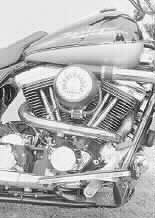Aerotech Turbo
After a great initial promise, turbochargers on two wheelers have earned themselves a bad name over the last decade and a half. They promised free power by extracting energy from otherwise wasted exhaust pressure. But the promise is only now coming to fruition.
A turbocharger is nothing new: The pre-industrial revolution watermill used the same technology. Submerge part of a wheel in a moving fluid and it will tend to turn. If it turns fast enough, you can install something on the other end of its axle that will perform work. This work can be anything from grinding corn for the local peasants to compressing the inlet charge of an engine.
If you're starting to get the impression that turbos are useless, join the crowd.
However, just like watermills, (how many of those have you seen lately) turbochargers have several problems: The most noticeable is turbo lag, and it makes turbos all wrong for motorcycles. Typically, motorcycle engines are high revving motors with little low-end grunt. The motorcyclist wants power all at once after turning the throttle from low speed. But at slow engine speeds, the exhaust pressure is low; the gas pressure in the pipe must build up before the turbocharger does any work So the engine must build up revs before the turbo really kicks in -- which is usually just when you don't want a huge burst of extra power.
Even worse, because the turbo increases combustion pressure so much, lower compression pistons are needed to prevent meltdown. So the performance of the turbocharged engine, when not in boost mode, is reduced below the stocker's.
Strike three, oil quality is critical in a turbo. The small turbine wheel has to turn very fast to do any work: typically, 100,000 rpm or more. At these speeds, a congealed oil particle can do much damage. The turbo's shaft must run in extra-clean oil, or its bearings will fail. The whole engine must be warmed up carefully, or thick, cold oil will not reach the bearings, and it must be cooled down carefully too, to prevent oil being burnt inside the bearings. If you're starting to get the impression that turbos are useless, join the crowd.
The solution? Use special high-speed bearings, located away from exhaust heat, with their own supply of lubricant. Restrict the effective size of the exhaust pipe, so the gas is always at high pressure, no matter what the engine speed. Aerocharger's patented process almost obliterates turbo lag -- making the motor think it is supercharged -- because they've come up with a way to keep exhaust gas velocity high at all engine speeds, by restricting the turbine inlet. Of course this restricts the available power a little, but Aerotech gives the rider a choice, with a high-low switch that turns on the full power of the turbo, lag and all.
There's no test instrument like the seat of the pants, so we asked the Aerotech guys for a test ride. "Of course" came the answer, "Which bike would you like to ride?" Aerotech operates half a dozen mobile test rigs -- all Harley Davidson powered -- ranging from an Ultra Glide to a Buell. In a situation like that, choice is always difficult, so we flipped a virtual coin and choose the Road King. Instantly, there's a raw surge of power. We've never felt a turbo come on so quickly, without a moment's hesitation or turbo lag.
The guys start the bike up and warm it carefully for just a couple of minutes, then it's handed over. The view from the rider's seat looks completely normal -- there's only one extra control to worry about, and that's the innocuous looking switch between the cylinders on the left side. It controls the turbo's boost pressure: Down is for low, up for high. Leaving it in the down position, we set off to find a piece of road uncrowded enough to test the turbo and open it up. Instantly, there's a raw surge of power. We've never felt a turbo come on so quickly, without a moment's hesitation or turbo lag. When the road opens up, and is clear in every direction, we flick the switch to high and whack the throttle open hard -- just a moment's lag, and again the power comes in with a rush, hard enough to slam the rider's backside down into the seat. We can't tell you anything about the next hour or two for fear of incrimination... let's just say it was loud and fast.
...we flick the switch to high and whack the throttle open hard -- just a moment's lag, and again the power comes in with a rush, hard enough to slam the rider's backside down into the seat.
Letting the Road King take a rest at the side of the asphalt it reigns over, we get the chance to take another look at the turbo. The installation is neat, with only the air cleaner cover giving the game away on the right side. The turbo sits below the rider's left foot, driven by modified exhaust pipes, and pushes air through a frame-mounted intercooler in the direction of the carburetor, a flatslide unit.
The kit is now available and legal in 49 states: California certification is being sought. Two versions of the kit are available -- one bargain basement version for around $3,000 that contains enough parts to get a substantial performance improvement. For the icing on the cake, another couple of grand gets you all the bells and whistles, including a turbo cam, good for several more horsepower over the stocker.
First Choice Turbo Center
1558 W. Henrietta Rd
East Avon, NY 14414
716-226-2929
More by Andy Saunders, Editor





























Comments
Join the conversation